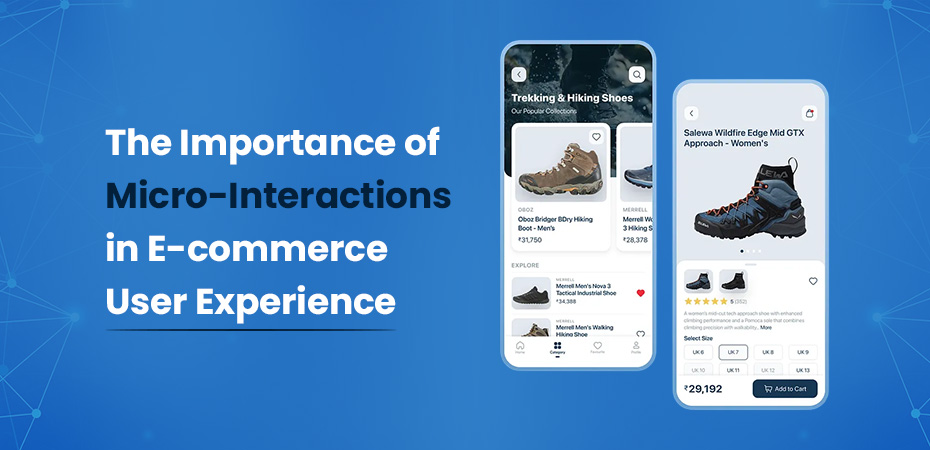The Importance of Micro-Interactions in E-commerce User Experience



The digital age has ushered in a new era of e-commerce, bringing with it a demand for sites that not only facilitate transactions but also engage and retain users. A crucial component of this user engagement is micro-interactions, small yet highly influential design elements that enhance user experience (UX). This article explores these important facets of e-commerce site design, discussing their utility, types, benefits, and best practices.
Understanding Micro-Interactions in the Sphere of E-commerce
Micro-interactions are tiny, often overlooked design elements that play a critical role in shaping the way users engage with a website or an application. They are the magic ingredients that enhance the user experience with their simplicity and subtleness. Their purpose is twofold:
- Firstly, they give feedback to the users. Say, for example, you tapped a button on an application. The button changes color, indicating that you have indeed pressed it. These cues, however small they might be, help users understand that their actions have been registered by the platform.
- Secondly, they introduce a fun, interactive element to the design. This might be as simple as a small animation when you refresh your feed, making the experience more engaging and less robotic.
In the context of micro eCommerce, these micro-interactions are often centered on completing a singular task. These tasks can range from adding a product to the cart, liking a product, or even getting a notification when a product you fancy is back in stock.
Let’s explore some micro interactions examples:
- Hover animations: Let’s say you are browsing a micro e-Commerce website to buy a shirt. As you hover over a particular shirt, the image might flip, showing you the back of the shirt. That’s a micro-interaction!
- Loading indicators: You have added your favourite book to the cart and have proceeded to pay. As the payment is processing, a spinning wheel appears. This honest and transparent communication helps keep the user informed and patient.
- Bouncing notifications: Whenever an item in your wishlist comes back in stock, a bouncing notification appears. This sort of playful interaction keeps users not only informed but also engrossed.
In essence, micro interaction design is a blend of art and science, which when done right, can make a world of difference to user experience. They might be ‘micro,’ but their impact is anything but miniature.
Exploring Different Micro-Interactions and their Significance in E-commerce
Micro-interactions are tiny but vital parts of any interface design. They guide users, give instant feedback, and make the digital environment more lively. These small design elements help in enhancing the user’s experience and interaction with the website. To understand them better, let’s look at some examples of micro-interactions and discuss their role in e-commerce.
| Type | Description | Example |
|---|---|---|
| Confirmation | Confirmation micro-interactions reassure users that their action was successfully completed. | A tick mark appears when a user adds an item to their shopping cart. |
| Tool-tip | Tool-tips provide extra details about a feature when a user hovers over it with their cursor. | A description appears when hovering over a dashboard button, explaining its function. |
| Notification | Notifications inform users about new updates, products, or offers to keep them engaged. | A pop-up appears when a product goes on sale, notifying the user. |
Micro-interactions may seem small, but they have a major role in refining the user experience. They offer subtle guidance to the user, improve the visual appeal of the website, and make the digital environment more user-friendly, especially in an e-commerce setup. Each micro-interaction type has its own importance and they all work together to enhance user involvement and satisfaction.
Examples of Interaction Design in E-commerce
In the exciting world of e-commerce, interaction design plays a crucial role in retaining customers and enhancing their buying experience. It is about creating an interactive and immersive environment for users. Implementing microinteractions is a great way to achieve an engaging interaction design. These micro elements not only help to make the website more lively but also help solve common user issues by providing hints and nudges as they navigate the web page.
The Utility of Micro-interactions in E-commerce
Recent studies have shown that having an easy-to-understand layout can help improve conversion rates by up to 200%. When this is paired with high-quality UX design, conversion rates can skyrocket up to 400%. One of the elements that greatly contribute to the strength of UX design is the use of micro-interactions.
Micro-interactions are small subtle animations integrated into a website’s design. Often coined as ‘micro animations UI’, they help to guide visitors as they explore a site. With use of these tiny animations, user experiences can be greatly enhanced and the website browsing process is more interesting and user-friendly.
- They provide immediate feedback on the user’s actions, assuring the user that their input has been recognized.
- They guide the user by subtly signposting the next user action.
- They create moments of delight that engage and retain the user.
A ‘web interactions gallery’ can be a great way to showcase these animations. This gallery will contain several examples of how micro-interactions can make a website more engaging. The gallery will serve as an inspiration source for businesses looking to improve their user interface.
Benefits of Employing Micro-Interactions
In the contemporary design world, micro-interactions have become an integral part of user interface design. These subtle animations and features play a significant role in enhancing user experience by making the user interface more appealing, navigable, and intuitive.
- Increased User Engagement: Micro-interactions can animate the user interface, making it more dynamic and interactive. This increased dynamism and interaction foster a more engaging experience and have the potential to hold user attention for longer periods. Studies suggest that engaging interfaces increase user interactions by up to 30%.
- Enhanced Functionality and Intuitiveness: Micro-interactions illuminate the functionality of different components of a website. They provide critical cues about what will happen next, thereby making the interfaces intuitive. Companies like Apple and Google have successfully utilized micro-interactions to make their platforms more user-friendly, contributing to their substantial market popularity.
- Simplified Navigation: Micro-interactions guide users through the process of navigating around the website, thus promoting user-centered design and making it user-friendly. A well-guided navigation increases user satisfaction by up to 38%.
- Error Prevention: Micro-interactions act as a user guide, helping to prevent mistakes by providing feedback and confirming user action, reducing user frustration and promoting an overall smoother experience.
Best Practices of Incorporating Micro-Interactions on an E-commerce Site
Web design has evolved sharply with the increasing function of the internet in our daily lives and micro-interactions have surfaced as quintessential elements in an interactive and engaging e-commerce site. Micro-interactions are subtle design elements — such as animations, effects, and other visual cues — that guide a user’s actions on a website or app. They can help bring a website to life, create intuitive UX/UI, and effectively lead customers through the sales funnel. However, successfully implementing these elements into your e-commerce website requires prudence and careful evaluation of user needs. Here are some best practices to keep in mind.
- Make Micro-interactions Intuitive: A micro-interaction design should always make sense to the user without explanation. Whether it’s a hover effect on a button, or an animation that denotes loading, it should seamlessly blend with the overall user experience. Statistics show 97% of users say ease of use is the most important mobile app characteristic, highlighting the importance of intuitive design.
- Ensure Instant Feedback: A fundamental aspect of micro-interactions is that they provide real-time feedback to user actions. This could range from a simple color change when a user taps a button or, a tick mark appearing when a task is accomplished. This approach assures the user that their action has been registered and processed, thereby enhancing user engagement and retention. As per a study, websites that offer real-time feedback have shown a 20% higher user engagement rate.
- Keep it Subtle: While micro-interactions can greatly improve a website’s UX/UI, it is crucial not to overwhelm the user with excessive animations or transitions. A clean, minimal design often works best and enhances e-commerce sales. In 2019, 55% of users claimed that a websites’ aesthetics influenced their purchase decisions.
Conclusion
Micro-interactions are essential for building an engaging and seamless e-commerce website. These small yet impactful elements enhance the user interface by providing feedback and interactivity, enriching the overall user experience. When integrated thoughtfully, micro-interactions can boost engagement, increase conversion rates, and improve user satisfaction on e-commerce platforms.
Incorporating well-designed micro-interactions is crucial for creating a smooth and dynamic browsing experience. To take your e-commerce site to the next level, Phoenix SEO Expert can help you optimize every element for maximum engagement and performance. Contact us today for expert guidance!
Frequently Asked Questions (FAQs)
Micro-interactions provide feedback, improve the website’s interface, and enhance user interaction to provide a better user experience. They can also animate the user interface and make it more engaging, thereby making the shopping process more enjoyable.
Micro-interactions can increase user engagement, enhance functionality and intuitiveness, and simplify navigation. Positive user experience can lead to increased conversion rates and better customer retention.
Expected micro-interactions should be intuitive and helpful, reinforcing the site’s functionality. They should be well-timed, not overly distracting, and provide value to enhance the customer shopping experience.
By improving user experience and making the site more user-friendly, micro-interactions can drive higher customer engagement. This can lead to increased time spent on the site and, consequently, higher chances of conversion.
Confirmation, tool-tips, and notification are some of the types of micro-interactions that work particularly well in e-commerce. They help users navigate the website, understand functionality, and keep them updated on relevant product-related information.